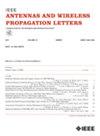基于柔性空腔的MIMO天线系统频率可重构自解耦新技术
IF 4.8
2区 计算机科学
Q2 ENGINEERING, ELECTRICAL & ELECTRONIC
引用次数: 0
摘要
针对多输入多输出(MIMO)天线系统,提出了一种新颖有效的频率重构和自解耦方法。作为演示,设计了一个双贴片天线系统,通过调整柔性腔的高度,实现了六种可重构状态,对应于不同的谐振频率和耦合效率。通过提升空腔,可以将电磁能量限制在每个空腔内,从而实现优越的端口隔离。通过样机制作和测试,验证了设计的正确性,实测结果与仿真结果吻合较好。当两个介质贴片天线(dpa)都处于up状态时,可实现最高的端口隔离,超过17.6 dB。与两个dpa都处于down状态的情况相比,这相当于最大耦合降低了6.49 dB。该方法实现了高端口隔离,无需额外的解耦结构,并支持频率重新配置,为新兴的MIMO系统提供了简单有效的解决方案。本文章由计算机程序翻译,如有差异,请以英文原文为准。
Novel Frequency-Reconfigurable and Self-Decoupling Technique for MIMO Antenna Systems Leveraging Flexible Air Cavities
A novel and effective method for frequency reconfiguration and self-decoupling is proposed for multiple-input–multiple-output (MIMO) antenna systems in this letter. As a demonstration, a two-patch antenna system is designed and achieves six reconfigurable states by adjusting the heights of the flexible cavities, corresponding to different resonant frequencies and coupling efficiencies. The electromagnetic energy can be confined within each cavity by elevating the cavities, leading to superior port isolation. The design is validated through prototype fabrication and testing, with the measured results closely aligning with the simulations. The highest port isolation, exceeding 17.6 dB, is achieved when both dielectric patch antennas (DPAs) are in the up state. This corresponds to a maximum coupling reduction of 6.49 dB compared to the scenario where both DPAs are in the down state. The proposed approach achieves high port isolation without the need for additional decoupling structures and enables frequency reconfiguration, offering a simple and efficient solution for emerging MIMO systems.
求助全文
通过发布文献求助,成功后即可免费获取论文全文。
去求助
来源期刊
CiteScore
8.00
自引率
9.50%
发文量
529
审稿时长
1.0 months
期刊介绍:
IEEE Antennas and Wireless Propagation Letters (AWP Letters) is devoted to the rapid electronic publication of short manuscripts in the technical areas of Antennas and Wireless Propagation. These are areas of competence for the IEEE Antennas and Propagation Society (AP-S). AWPL aims to be one of the "fastest" journals among IEEE publications. This means that for papers that are eventually accepted, it is intended that an author may expect his or her paper to appear in IEEE Xplore, on average, around two months after submission.

 求助内容:
求助内容: 应助结果提醒方式:
应助结果提醒方式:


